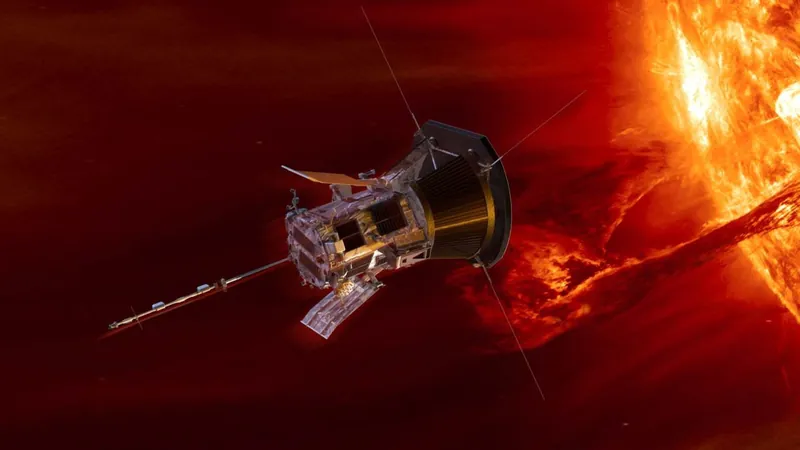
NASA's Parker Solar Probe: Unraveling the Sun's Secrets with Groundbreaking Discoveries!
2024-11-18
Author: Yu
Introduction
On November 6, NASA's Parker Solar Probe completed a remarkable flyby, coming within just 234 miles (376 kilometers) of Venus' surface. This maneuver was a strategic gravity assist, allowing the probe to harness some of Venus' momentum and adjust its orbit to delve even deeper into the sun's mysteries.
Record-Breaking Flyby
Previously, the Parker Solar Probe has made several daring approaches to the sun, but this particular flyby marked a thrilling new chapter in its mission. It reached an astonishingly close distance of approximately 3.8 million miles (6 million km) from the sun itself—less than nine times the sun's radius. At its closest approach, the spacecraft was hurtling through space at an incredible speed of nearly 435,000 miles per hour (700,000 kilometers per hour), setting the record as the fastest human-made object ever. To put that in perspective, Parker’s speed is roughly 0.06% of the speed of light!
Investigating the Corona
The primary mission of the Parker Solar Probe is to investigate the enigmatic sun's corona, the outermost layer of its atmosphere. For decades, scientists have puzzled over the paradox of the sun: while the visible surface, known as the photosphere, burns at a cool few thousand kelvins, the corona soars to millions of kelvins. It’s akin to turning on a light bulb that feels warm, only to realize the air surrounding it is a thousand times hotter—a phenomenon that defies logic.
The Heating Paradox
Heat transfer processes dictated by the second law of thermodynamics cannot explain this anomaly. Thus, the cause of this heating must involve magnetic fields that perform a dynamic role in the corona's physics. Interestingly, it takes far less energy to heat the corona than one might think, primarily due to the unique behavior of helium, which constitutes about 25% of the sun's mass.
Helium's Role in Heating
In the cooler environments of the photosphere, helium atoms lose one electron, entering a state that allows them to emit radiation easily. However, as temperatures rise and helium becomes fully ionized, it retains heat rather than releasing it, contributing to the intense warmth of the corona. In layman's terms, this transition is reminiscent of boiling water into steam, a metaphor astronomers use to describe the heating process.
Energy Requirements for Heating the Corona
The stellar findings imply that to achieve the extreme temperatures of the corona, we only need a modest supply of energy—around 1 kilowatt for each square meter of the sun's surface. This minuscule amount equates to less than 0.0025% of the sun's total energy output, implying that heating the corona could be more inefficient and still effective than previously assumed.
Advanced Instrumentation of the Parker Solar Probe
To facilitate its explorations, Parker Solar Probe is equipped with four sophisticated instrument suites known as FIELDS, WISPR, ISʘIS, and SWEAP. These advanced tools work synergistically to analyze the corona, the solar wind (the stream of charged particles from the corona), and the photosphere, aiming to paint a complete picture of solar activity.
Discovery of Magnetic-Field Waves
Recently, the Parker Solar Probe has made an astonishing discovery regarding unusual magnetic-field waves termed "switchbacks." These phenomena originate from the turbulent motions within the photosphere, where plasma rises and falls. In regions of intense magnetic energy, field lines can intermingle, creating straight structures that extend away from the sun alongside looping lines that curve back towards the surface.
Understanding Switchbacks
When these contrasting magnetic fields meet, they can disconnect and reconnect, producing a distinctive S-shaped kink – the hallmark of a switchback. As this kink travels outward, it carries energy deep into the corona before dissolving. Astronomers believe this process may be one of the most critical mechanisms, if not the foremost means, by which the sun's corona is heated.
Looking Ahead
As the Parker Solar Probe continues its groundbreaking mission, we remain on the edge of our seats, eagerly anticipating the further revelations it will bring about our closest star. What other cosmic secrets will this incredible probe uncover? Stay tuned for updates on this extraordinary journey into the heart of our solar system!



 Brasil (PT)
Brasil (PT)
 Canada (EN)
Canada (EN)
 Chile (ES)
Chile (ES)
 España (ES)
España (ES)
 France (FR)
France (FR)
 Hong Kong (EN)
Hong Kong (EN)
 Italia (IT)
Italia (IT)
 日本 (JA)
日本 (JA)
 Magyarország (HU)
Magyarország (HU)
 Norge (NO)
Norge (NO)
 Polska (PL)
Polska (PL)
 Schweiz (DE)
Schweiz (DE)
 Singapore (EN)
Singapore (EN)
 Sverige (SV)
Sverige (SV)
 Suomi (FI)
Suomi (FI)
 Türkiye (TR)
Türkiye (TR)